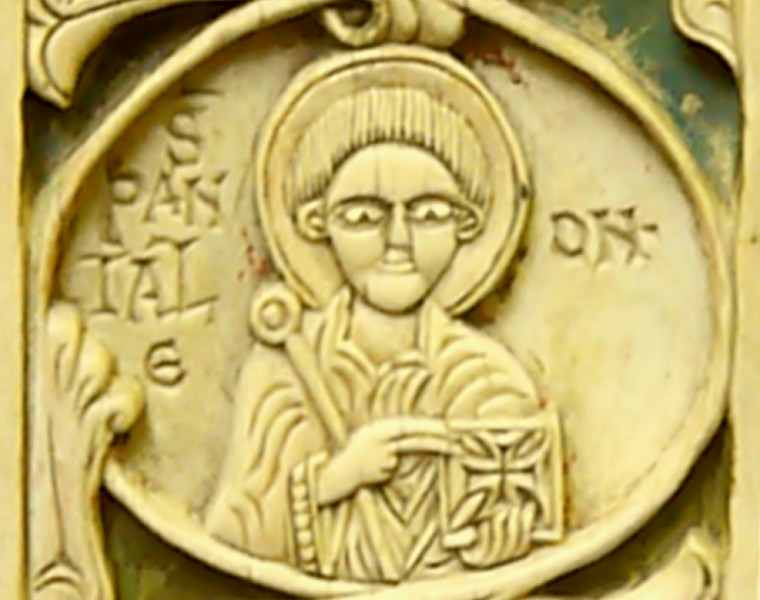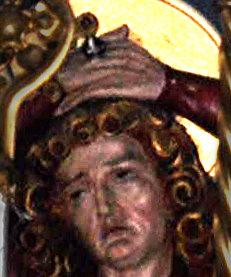Except for a few 19th-century statues, the images consistently make St. Pantaleon a beardless young man. This is how he looks in the Miracula when he appears to those who call on him for help (ibid., 421-26).
The earliest images have the saint pointing to a book with a cross on it, as in the picture above right, which also places a medical instrument of some sort between his chest and right arm. Most subsequent images make the instrument a thin, elongated object or a spoon and put a box of medicaments in the other hand, as in the second picture at right. When rendered as a thin, elongated object, the instrument resembles those used in medieval cataract surgery; this may relate to the story in the Vita in which Pantaleon cures a blind man (ibid., 413-14).
Less often, the instrument is replaced by a cross and/or olive branch (example). After Pantaleon was killed, the olive tree to which he had been tied came into fruit (ibid., 420). Sometimes there is also a sword to reference the martyrdom (example).
In group images of the 14 Holy Helpers, St. Pantaleon is sometimes shown as in the third picture at right – holding the top of his head, into which a spike has been driven. The Wikipedia article (retrieved 2014-09-04) and a Catholic web site say he is invoked against headaches. The Wikipedia article also says there is an alternative Life in which his hands were nailed to his head, but I have looked through a variety of medieval hagiographical and liturgical materials and found nothing of the sort. And the spike is always shown inserted between two fingers. Most likely the spike and the connection with headaches arise from the variety of cures and exorcisms attributed to St. Pantaleon during and after his life. Especially relevant is the Vita's remark that in his lifetime he was able to cure those qui tormentis vexabantur ("who were troubled with pain," ibid., 415).
Prepared in 2014 by Richard Stracke, Emeritus Professor of English, Augusta University

Ivory from the 10th or 11th century (See the description page.)
Russian icon (See the description page.)

Detail of a 19th century relief of the 14 Holy Helpers (See the description page.)
ATTRIBUTES
- Long spoon
- Box of medicaments
- Nail in head
DATES
- Feast day: July 27
- Died in 304
BIOGRAPHY
- Roman Breviary: English translation, III, 761-62; 1632 Latin version, 946-47.
- Acta Sanctorum July vol. 6, 397-426.
- "Miracula S. Pantaleonis," in the Windbergen Legendary, ed. Carolus de Smedt et al., Analecta Bollandiana, XVII (1898), 179-190.